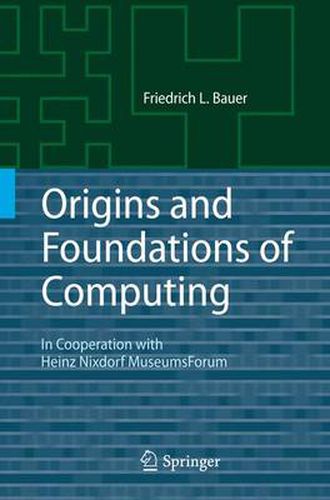Readings Newsletter
Become a Readings Member to make your shopping experience even easier.
Sign in or sign up for free!
You’re not far away from qualifying for FREE standard shipping within Australia
You’ve qualified for FREE standard shipping within Australia
The cart is loading…






This title is printed to order. This book may have been self-published. If so, we cannot guarantee the quality of the content. In the main most books will have gone through the editing process however some may not. We therefore suggest that you be aware of this before ordering this book. If in doubt check either the author or publisher’s details as we are unable to accept any returns unless they are faulty. Please contact us if you have any questions.
The Heinz Nixdorf Museum Forum (HNF) is the world’s largest c- puter museum and is dedicated to portraying the past, present and future of information technology. In the Year of Informatics 2006 the HNF was particularly keen to examine the history of this still quite young discipline. The short-lived nature of information technologies means that individuals, inventions, devices, institutes and companies age more rapidly than in many other specialties. And in the nature of things the group of computer pioneers from the early days is growing smaller all the time. To supplement a planned new exhibit on Software and Inform- ics at the HNF, the idea arose of recording the history of informatics in an accompanying publication. Mysearchforsuitablesourcesandauthorsveryquickly cameupwith the right answer, the very rst name in Germany: Friedrich L. Bauer, Professor Emeritus of Mathematics at the TU in Munich, one of the - thers of informatics in Germany and for decades the indefatigable author of the Historical Notes column of the journal Informatik Spektrum. Friedrich L. Bauer was already the author of two works on the history of informatics, published in different decades and in different books. Both of them are notable for their knowledgeable, extremely comp- hensive and yet compact style. My obvious course was to motivate this author to amalgamate, supplement and illustrate his previous work.
$9.00 standard shipping within Australia
FREE standard shipping within Australia for orders over $100.00
Express & International shipping calculated at checkout
This title is printed to order. This book may have been self-published. If so, we cannot guarantee the quality of the content. In the main most books will have gone through the editing process however some may not. We therefore suggest that you be aware of this before ordering this book. If in doubt check either the author or publisher’s details as we are unable to accept any returns unless they are faulty. Please contact us if you have any questions.
The Heinz Nixdorf Museum Forum (HNF) is the world’s largest c- puter museum and is dedicated to portraying the past, present and future of information technology. In the Year of Informatics 2006 the HNF was particularly keen to examine the history of this still quite young discipline. The short-lived nature of information technologies means that individuals, inventions, devices, institutes and companies age more rapidly than in many other specialties. And in the nature of things the group of computer pioneers from the early days is growing smaller all the time. To supplement a planned new exhibit on Software and Inform- ics at the HNF, the idea arose of recording the history of informatics in an accompanying publication. Mysearchforsuitablesourcesandauthorsveryquickly cameupwith the right answer, the very rst name in Germany: Friedrich L. Bauer, Professor Emeritus of Mathematics at the TU in Munich, one of the - thers of informatics in Germany and for decades the indefatigable author of the Historical Notes column of the journal Informatik Spektrum. Friedrich L. Bauer was already the author of two works on the history of informatics, published in different decades and in different books. Both of them are notable for their knowledgeable, extremely comp- hensive and yet compact style. My obvious course was to motivate this author to amalgamate, supplement and illustrate his previous work.